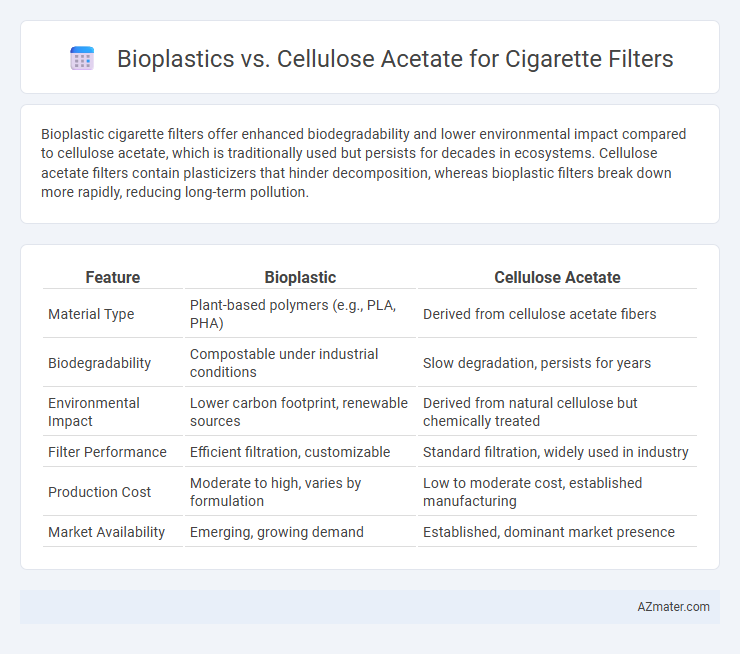Bioplastic cigarette filters offer enhanced biodegradability and lower environmental impact compared to cellulose acetate, which is traditionally used but persists for decades in ecosystems. Cellulose acetate filters contain plasticizers that hinder decomposition, whereas bioplastic filters break down more rapidly, reducing long-term pollution.
Table of Comparison
| Feature | Bioplastic | Cellulose Acetate |
|---|---|---|
| Material Type | Plant-based polymers (e.g., PLA, PHA) | Derived from cellulose acetate fibers |
| Biodegradability | Compostable under industrial conditions | Slow degradation, persists for years |
| Environmental Impact | Lower carbon footprint, renewable sources | Derived from natural cellulose but chemically treated |
| Filter Performance | Efficient filtration, customizable | Standard filtration, widely used in industry |
| Production Cost | Moderate to high, varies by formulation | Low to moderate cost, established manufacturing |
| Market Availability | Emerging, growing demand | Established, dominant market presence |
Introduction to Cigarette Filter Materials
Cigarette filters primarily consist of cellulose acetate, a synthetic polymer derived from cellulose fibers, known for its effective filtration and affordability. Bioplastics, derived from renewable biomass sources such as corn starch or sugarcane, are emerging as sustainable alternatives with comparable filtration efficiency and biodegradability. The choice between cellulose acetate and bioplastic filters influences environmental impact, biodegradation rates, and manufacturing costs within the tobacco industry.
Understanding Bioplastics: Composition and Properties
Bioplastics used in cigarette filters primarily consist of renewable plant-based polymers such as polylactic acid (PLA) and starch blends, offering biodegradability and reduced environmental impact compared to conventional plastics. These materials exhibit favorable filtration efficiency and mechanical strength while gradually decomposing under industrial composting conditions. The chemical structure of bioplastics promotes lower toxicity and less residue post-consumption, making them a sustainable alternative to cellulose acetate filters.
What is Cellulose Acetate?
Cellulose acetate is a biodegradable polymer derived from cellulose, the natural polymer found in plant cell walls, commonly used as a primary material in cigarette filters due to its effective filtration properties and lightweight nature. Unlike conventional plastic filters made from petroleum-based materials, cellulose acetate offers enhanced environmental compatibility by breaking down more efficiently under certain conditions, though it still poses ecological concerns when improperly disposed of. Advances in bioplastic alternatives aim to improve sustainability by utilizing renewable resources, but cellulose acetate remains the industry standard for cigarette filter production.
Environmental Impact of Bioplastics in Filters
Bioplastic cigarette filters leverage renewable biomass sources, significantly reducing reliance on fossil fuels and lowering carbon emissions compared to cellulose acetate filters derived from petrochemicals. Their biodegradability enhances environmental sustainability by minimizing long-term microplastic pollution in ecosystems. However, variations in bioplastic composition and disposal conditions influence degradation rates, necessitating comprehensive lifecycle assessments to fully gauge their ecological benefits.
Cellulose Acetate and Its Ecological Footprint
Cellulose acetate, a semi-synthetic polymer derived from cellulose, is the dominant material used in cigarette filters due to its effective filtration properties and low production cost. However, its ecological footprint is significant as it is slow to biodegrade, often persisting in the environment for years and contributing to plastic pollution in aquatic and terrestrial ecosystems. Despite being derived from a natural polymer, the chemical processes involved in its production and its resistance to microbial degradation pose challenges for sustainable disposal and environmental health.
Biodegradability: Bioplastic vs Cellulose Acetate
Bioplastic cigarette filters offer enhanced biodegradability compared to conventional cellulose acetate filters by breaking down more rapidly in natural environments due to their composition of renewable polymers like polylactic acid (PLA). Cellulose acetate filters, while partially biodegradable, persist in the environment for years because their synthetic additives slow microbial degradation. Choosing bioplastic filters significantly reduces cigarette litter's environmental impact by accelerating filter decomposition and decreasing microplastic pollution.
Performance and Filtration Efficiency Compared
Bioplastic cigarette filters typically offer enhanced biodegradability but often exhibit lower filtration efficiency compared to cellulose acetate due to their different fiber structures and porosity levels. Cellulose acetate filters provide superior particulate and tar retention, resulting in better smoke filtration performance critical for reducing harmful substance inhalation. Though bioplastics have improved environmental profiles, cellulose acetate remains the industry standard for balanced filtration efficiency and user experience in cigarette filters.
Cost Analysis: Bioplastic vs Cellulose Acetate Production
Bioplastic production for cigarette filters generally incurs higher raw material and processing costs compared to cellulose acetate, driven by the use of renewable feedstocks like PLA or PHA and specialized manufacturing techniques. Cellulose acetate benefits from established industrial-scale production with lower feedstock expenses, primarily derived from abundant cellulose sources, making it more cost-effective for mass production. However, bioplastics offer potential long-term economic advantages through regulatory incentives and consumer demand for sustainable alternatives, balancing initial cost disparities in the market.
Market Adoption and Regulatory Perspectives
Bioplastic cigarette filters are gaining market adoption due to increasing consumer demand for biodegradable alternatives and stringent environmental regulations aimed at reducing plastic pollution. Cellulose acetate, traditionally dominant in filters, faces growing regulatory scrutiny as microplastic concerns mount and several countries implement bans or restrictions on non-biodegradable filters. Regulatory frameworks are accelerating industry shifts toward bioplastic materials that meet eco-friendly standards while maintaining performance, driving investment and innovation in sustainable filter technologies.
Future Trends in Sustainable Cigarette Filters
Bioplastic and cellulose acetate represent pivotal materials shaping the future of sustainable cigarette filters, with bioplastics offering biodegradability and reduced environmental impact. Innovations in bio-based polymers and enhanced compostability position bioplastics as preferable alternatives to traditional cellulose acetate, which poses significant microplastic pollution challenges. Emerging research emphasizes combining bioplastic composites with enzymatic treatments to accelerate degradation rates and minimize ecological footprints in cigarette waste management.

Infographic: Bioplastic vs Cellulose Acetate for Cigarette Filter
 azmater.com
azmater.com